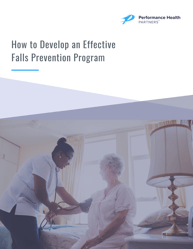
How to Develop an Effective Falls Prevention Program

A falls prevention program is an effective culmination of tools that provides an individualized care plan that can be consistently followed by the healthcare team to prevent patient injury and avoid costs associated with the diagnosis and treatment of falls-related injuries.
In this whitepaper, you’ll learn:
- Cornerstones of a falls prevention program
- Cost effective best practices in preventing inpatient falls
- Outcomes of an effective program
To download, fill out form below.
The Agency for Health Care Research and Quality estimates that approximately 700,000 to 1 million people fall in hospitals in the United States every year. Of those, 30 to 40% lead to injuries that can result in an average of 6.3 additional hospital days to a patient’s hospital stay and an average cost of $14,000 to diagnose and treat those injuries.
Research has shown that there are several factors that have a demonstrable link to an increased risk of falls. They include but are not limited to:
- Inadequate or poor risk assessment
- A breakdown in communications or poor communication processes
- Failure to adhere to existing protocols and safety best practices
- Poor staff training and supervision
- Poor physical environment
An effective falls prevention program is designed to consider all these issues, and ensures the adherence to evidence-based fall prevention best practices.
Ensure Patient Safety with a Data-Driven Falls Prevention Program
The essential components of successful fall prevention include identifying and managing each patient’s underlying fall risk factors while optimizing the physical environment to avoid creating fall hazards within the hospital.
Any fall prevention program should be based on real-life scenarios, which is why your fall risk analysis should be data-driven and systematic to consider specific factors unique to your organization. Therefore, your fall risk analysis should be an ongoing process.
To help prevent patient falls, using a centralized patient safety technology solution like Performance Health Partners’ allows your organization to collect consistently, analyze, and track data so that you can identify root causes of patient falls and subsequently update your protocols to ensure that you remain at the cutting edge of fall prevention.
An effective falls prevention program can drastically decrease the overall number of patient falls in a healthcare environment. It’s not uncommon to see a 25-50% reduction in falls after implementing a falls program.
Achieve the Highest Quality Care in the Safest Possible Environment
With our KLAS-rated healthcare safety solutions, Performance Health Partners helps healthcare organizations provide the highest quality care in the safest possible environment.
Our Incident Reporting system helps care teams proactively identify fall and other patient safety risks to get ahead of incidents before they happen. With our software, care teams can:
Easily report incidents. Our intuitive and fully customizable forms allow team members to report incidents, events, complaints, and near misses in under two minutes.
Manage follow-up and safety improvements. Automatic alerts and workflows notify team members and departments to review reported incidents. Streamlined tools drive patient and employee safety by breaking down communication silos.
Make data-driven decisions. Real-time dashboards with drill-through reporting empower teams to identify gaps in employee and patient safety, prioritize performance improvement initiatives, and prevent future incidents from reoccurring.
Start Preventing Falls Today
With Performance Health Partners, improving outcomes has never been easier. Request a free demo with our team to discuss your safety needs and learn how our tools might be the right fit for your organization.

